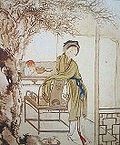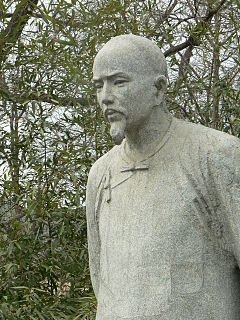- Cao Xueqin
-
Cao Xueqin
Statue of Cao Xueqin in BeijingBorn 1715 or 1724
Nanjing, ChinaDied 1763 or 1764
Beijing suburbsOccupation Novelist, poet, philosopher, painter
InfluencedThis is a Chinese name; the family name is Cao.Cao Xueqin (Chinese: 曹雪芹; pinyin: Cáo Xuěqín; Wade–Giles: Ts'ao Hsueh-ch'in, 1715[1] or 1724[2] — 1763[1] or 1764[3]) was a Qing Dynasty Chinese writer, best known as the author of Dream of the Red Chamber, one of the Four Great Classical Novels of Chinese literature. His given name was Cao Zhan (曹霑) and his courtesy name is Mengruan (夢阮; 梦阮; literally "Dream about Ruan" or "Dream of Ruan").
Contents
Family
Cao was born to a Han Chinese clan[4] that was forced into slavery (as booi aha or bondservants) to the Manchu royalty in the late 1610s, his ancestors distinguished themselves through military service in the Plain White Branch (正白旗) of the Eight Banners and subsequently held posts as officials.[5]
During the Kangxi Emperor's reign, the clan's prestige and power reached its height. Cao's grandfather, Cao Yin (曹寅), was a childhood playmate to Kangxi while Cao Yin's mother, Lady Sun (孫氏), was Kangxi's wet nurse. Two years after his ascension, Kangxi appointed Cao's great-grandfather, Cao Xi (曹璽), as the Commissioner of Imperial Textiles (織造) in Jiangning, and the family relocated there.
When Cao Xi died in 1684, Cao Yin, as Kangxi's personal confidante, took over the post. Cao Yin was one of the era's most prominent men of letters and a keen book collector. By the early 18th century, the Cao clan had become so rich and influential as to be able to play host four times to the Kangxi Emperor in his six separate itinerant trips south to the Nanjing region.
When Cao Yin died in 1712, Kangxi, still in power, passed the office over to Cao Yin's only son, Cao Yong (曹顒). Cao Yong died in 1715. Kangxi then allowed the family to adopt a paternal nephew, Cao Fu (曹頫), as Cao Yin's posthumous son to continue in that position. Hence the clan held the office of Imperial Textile Commissioner at Jiangning for three generations.
The family's fortunes lasted until Kangxi's death and the ascension of the Yongzheng Emperor to the throne. Yongzheng severely attacked the family and later confiscated their properties, while Cao Fu was thrown in jail.[5] This was for their mismanagements of funds. Many believe this purge was politically motivated. When Cao Fu was released a year later, the family, completely impoverished, was forced to relocate to Beijing. Cao Xueqin, still a young child then, lived in poverty with his family.
Life
Almost no records of Cao's early childhood and adulthood survive. Redology scholars are still debating Cao's exact date of birth, though he is known to be around forty to fifty at his death. Cao was the son of either Cao Fu or Cao Yong. It is known for certain that Cao Yong's only son was born posthumously in 1715; some Redologists believe this son might be Cao Xueqin.
Most of what we know about Cao was passed down from his contemporaries and friends. Cao eventually settled in the western suburbs of Beijing where he lived the larger part of his later years in poverty selling off his paintings. Cao was recorded as an inveterate drinker. Friends and acquaintances recalled an intelligent, highly talented man who spent a decade working diligently on a work that must have been Dream of the Red Chamber. They praised both his stylish paintings, particularly of cliffs and rocks, and originality in poetry, which they likened to Li He's. Cao died some time in 1763 or 1764, leaving his novel in a very advanced stage of completion. (The first draft had been completed, some pages of the manuscript were lost after being borrowed by friends or relatives.) He was survived by a wife after the death of a son.
Cao achieved posthumous fame through his life's work. The novel, written in "blood and tears", as a commentator friend said, is a vivid recreation of an illustrious family at its height and its subsequent downfall. A small group of close family and friends appears to have been transcribing his manuscript when Cao died quite suddenly in 1763-4, apparently out of grief owing to the death of a son. Extant handwritten copies of this work – some 80 chapters – had been in circulation in Beijing shortly after Cao's death and scribal copies soon became prized collectors' items.
In 1791, Cheng Weiyuan (程偉元) and Gao E (高鶚), who claimed to have access to Cao's working papers, published a "complete", edited a 120-chapter version. This is its first moveable type print edition. Reprinted a year later with more revisions, this 120-chapter edition is the novel's most printed version. Modern scholars generally think the authorship of the 1791 ending – the last 40 chapters – to be in doubt.[1]
See also
- Chinese literature
- List of Chinese authors
Notes
- ^ a b c Briggs, Asa *(ed.) (1989) The Longman Encyclopedia, Longman, ISBN 0582916208
- ^ Zhou, Ruchang. Cao Xueqin. pp. 230–233.
- ^ Zhang Yiquan: Hong lou meng volume 1. p.2 cited in the introduction to The Dream of the Red Chamber. by Li-Tche Houa and Jacqueline Alézaïs.La Pléiade 1979
- ^ Tanner, Harold Miles (2008). China: A history. Indianapolis, Ind.: Hackett. p. 363. ISBN 9780872209152. http://books.google.com/books?id=VIWC9wCX2c8C&dq.
- ^ a b China: Five thousand years of history and civilization. Hong Kong: City University of Hong Kong Press. 2007. pp. 722. ISBN 9789629371401. http://books.google.com/books?id=z-fAxn_9f8wC.
References
- Liu, Shide, "Cao Xueqin". Encyclopedia of China, 1st ed.
External links
Dream of the Red Chamber (紅樓夢/红楼梦) Four Great Classical Novels • Cao Xueqin • RedologyText and
commentariesRouge Inkstone • Odd Tablet • Cheng-Gao versions • Gao E
Characters Twelve Beauties of Jinling: Lin Daiyu • Xue Baochai • Jia Yuanchun • Jia Tanchun • Shi Xiangyun • Miaoyu • Jia Yingchun • Jia Xichun • Wang Xifeng • Jia Qiaojie • Li Wan • Qin Keqing
Secondary characters: Granny Liu • Xue Pan • Qin Zhong • Zhen Baoyu
Masters: Jia Baoyu • Jia Zheng • Jia She • Jia Zhen • Jia Lian • Jia Rong • Jia Lan • Jia Huan • Jia Yun
Ladies: Grandmother Jia • Lady Wang • Aunt Xue • Lady Xing • Lady You • Concubine Zhao
Maids: Ping'er • Yuanyang • Xiren • Qingwen • Zijuan • Xiangling • Sheyue • Xiaohong • Xueyan • JinchuanRedologists Cai Yuanpei • Hu Shih • Yu Pingbo • Wu Shichang • Zhou Ruchang • Eileen Chang • Feng Qiyong • Cai Yijiang • Liu Xinwu • QigongAdaptations Dream of the Red Chamber (1944 film) • Dream of the Red Chamber (1987 TV series) • A Dream in Red Mansions (2010 TV series)Categories:- Chinese historical novelists
- Chinese-language writers
- Chinese novelists
- Qing Dynasty writers
- Dream of the Red Chamber
- 1724 births
- 1763 deaths
Wikimedia Foundation. 2010.

